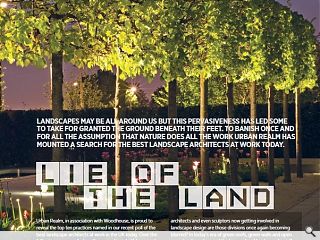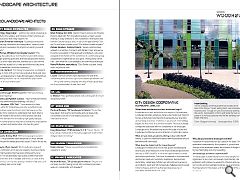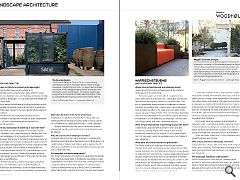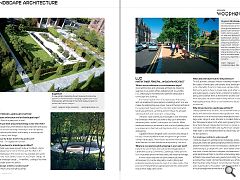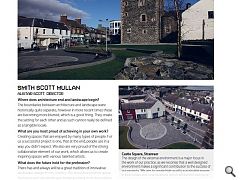Top Landscape Architects
13 Jul 2012
Landscapes may be all around us but this pervasiveness has led some to take for granted the ground beneath their feet. To banish once and for all the assumption that nature does all the work Urban Realm has mounted a search for the best landscape architects at work today.
Urban Realm, in association with Woodhouse, is proud to reveal the top ten practices named in our recent poll of the best landscape architects at work in the UK today.
Here we feature those practices, both large and small, which have moved the earth for both clients and public.
Thousands of votes were received via the Urban Realm website and we’ve compiled some of the best comments here, as well as the results of our extensive interviews and Q&A’s with many of the winning teams. Together these paint an arresting snapshot of an industry in transition, outlining its path to growth and highlighting the long term future for this most long term of professions.
Landscape architects long ago carved out a distinctive niche for themselves in the building industry but with many
architects and even sculptors now getting involved in landscape design are those divisions once again becoming blurred? In today’s era of green roofs, green walls and open aspects where does architecture end and landscape begin?
Most buildings remain resolutely static (bar a spot of weathering or later renovation), the natural world, in contrast, remains pleasingly dynamic; shifting dramatically in appearance from hour to hour, season to season. These changes place a burden of insight on their designers to a degree which most other professions would greatly benefit and which imparts all the more depth to the best designs.
Here we explore these and other issues within an industry increasingly confi dent in its achievements today and its prospects tomorrow.
TOP 10 LANDSCAPE ARCHITECTS
1, CITY DESIGN COOPERATIVE
Hamish Bigg, Bigg Design: “I admire City Design Cooperative especially for the subtlety and richness of their schemes, an excellent practice that really inspires me.”
Neil Lochiel, Riverside Inverclyde: “Superbly professional team, applying themselves with imagination, creativity and implementation excellence for projects of varying size and complexity.”
Maisie McCrae, Whiteinch Community Council: “This company has advised our Community Council with various land scape planning questions and have always been helpful pointed us in the right direction, followed up to see how we got on and has guided us to make good informed decisions that have benefited the whole community.”
Alex Currie, Ramboll: “City Design Cooperative is a fantastic company to work with as they have a great attitude and have the skills and experience to make things happen. Richard East and his team provide a ‘can do’ environment which filters through to the rest of the team.”
02 ERZ
Adam Scarborough, NVA Europe Ltd: “ERZ are visionary, honest, and inspiring.”
Alex Brown, East Ayrshire Council: “I have worked with these people they know what placemaking is all about.”
Andrew Vaughan, UPM Tihill: “I have worked on three projects with ERZ Ltd and have not only found them to be
highly professional and profi cient, but they have gone the extra mile (in my opinion) to understand their client brief, to thoroughly research the context of their project sites and to bring this forward with innovative, high quality designs. Although a small practice, they have exceeded my expectations - having worked with several other LA’s over the years.”
03 BCA LANDSCAPE
Leon Russell, Smiling Wolf: “BCA are a young innovative practice. The passionate team always tell the most brilliant stories through the landscapes they design. They’re the tip top pick!”
Garry Payne, Wyre Council: “BCA Landscape engaged with the community from day one resulting in a fi nal scheme (Marine Hall Gardens) that has been embraced by local residents! The exceptionally high quality scheme has been delivered on time and on budget and will be an asset to the Council and its communities putting the Marine Hall and iconic 1920’s building back on the map!”
04 RANKIN FRASER
Brian McGraw, GCC DRS, “Rankin Fraser’s work on the Phoenix Flowers allied with 7N’s innovation has been a major success levering in many times the £1.4m investment in the fl owers into the new Cultural campus area. At last count approaching £16m and I’m sure is set to reach circa £20m within a couple of years.”
Michael Davidson, Icosis Architects: “We as a practice have worked on a number of projects with Rankin Fraser who we’ve found to be excellent in their approach and delivery. I also work alongside Chris Rankin on the committee of a community group established to regenerate our local park - Montgomery Street Park - and know him to be energetic and committed individual.”
Henry McKeown, jmarchitects: “Chris Rankin is a gem, lovely work, he gets our vote.”
05 HARRISONSTEVENS
C Scott: “Harrison Stevens have impressed me with their consistently fresh and new approach to landscape architecture. An up and coming company with lots of fresh, great ideas and the professionalism to see them built.”
06 LUC
S. Wallace: “Very professional and work well as part of a multidisciplinary team.”
07 GROSS MAX
Matthew Benians, TGP Landscape Architects: “Gross Max have taken their practice worldwide and are deservedly considered to be one of the leading practices in an international forum.”
08 ENVERT STUDIO
Doug Wheatland, CZWG Architects LLP: “Envert Studio LLP have always maintained an innovative approach to all of their designs! Quite refreshing.”
09 HORNER + MACLENNAN
Robin Johnson: “Always very professional and listen to customer’s needs.”
10 IAN WHITE ASSOCIATES
Matthew Benians, TGP Landscape Architects: “Despite the company founder having retired, IWA continue to produce work of a consistently high standard.”
CITY DESIGN COOPERATIVE
RICHARD EAST, DIRECTOR
Where does architecture end and landscape begin?
Landscape is context and architecture begins in the landscape. Landscape provides a physical, cultural and intellectual milieu for human activity but more than this it represents ever changing and evolving processes. It reminds us we are part of something bigger and that none of us works in isolation. The best buildings correspond beautifully with the complexity of the landscape.
Landscape is not the green strip around the edge of a site and Landscape Architecture is not a dictionary of Latin plant names.
What are you most proud of achieving in your own work?
Nearly 30 years of creative and award winning schemes and still brimming with new ideas!
What does the future hold for the profession?
Landscape Architecture in the UK has grown and developed enormously since the boom of the environmental improvement industry of 1970s and 80s. It is a more sophisticated, focussed and creative profession. At its best it responds to environmental and human needs with sensitivity, inspiration, inventiveness and artistry. Landscape Architecture will continue to advance according to needs and will increasingly challenge preconceived notions of space and form as the relentless pressures of population growth impact on us all.
Why did you become a landscape architect?
A passion for space matched by a passion for place. Reading space and understanding the dynamics of growth and change in the landscape makes the process of design both highly challenging and very rewarding.
Are landscape architects undervalued?
The landscape is undervalued by too many people. Its significance is too often overlooked. Optimistically, the
profession will continue to expand its influence and expertise, and society will increasingly recognise, value and respect the imperative for the
ERZ
ROLF ROSCHER, DIRECTOR
Where does architecture end and landscape begin?
It depends at what scale you are looking at it? Landscape can be considered at vastly different scales: regional, city, neighbourhood, site. Buildings are fundamentally a component of landscape. It is only at the site level where the answer is less clear.
Thinking about the built and un-built environments should not be separate processes. I would argue that this separation is one of the major causes of the many dysfunctional spaces in urban Scotland. On the site level, the relationship between the two elements needs to be explored through an open collaborative process. The best collaborations are not hindered by professional boundaries.
What are you most proud of achieving in your own work?
It depends when you ask the question? In the past: Agnew Park (in Stranraer), the Hidden Gardens (in Glasgow) and Cow Chapel (an installation in the US with artist Paul Chidester). More recent ERZ projects: the SAGE strategy and some of the other strategy work we have produced: the green network strategy for urban Inverclyde and the current Integrated Green Infrastructure studies.
Also a number of masterplans: the Hanley Stoke masterplan (with NORD), the masterplan for the
David Livingstone Centre etc. Some of our smaller projects like the natural play area at Merrylee Primary also feel like they have made a real difference.
The St Peter’s Seminary / Kilmahew project led by NVA is amazing. The masterplan came out of three years of
research, dialogue and thinking. It is a multi-layered and very sophisticated project. Our best projects haven’t yet been built! What does the future hold for the profession? Greatness. It is a profession for the 21st Century. The core challenges that we face (as a society) relate at every scale to the core skills of the Landscape Architect / Urban Designer.
I believe ultimately that the current constraints of poor professional standing and barriers in procurement processes will change.
Why did you become a landscape architect?
It involves everything that I am interested in. Designing the physical environment offers the opportunity to think about the fundamentals of ‘nature’ and ‘culture’ and to explore the rich ideas and complexities of how people influence landscape and how it influences them.
Are landscape architects undervalued?
Yes. The infrastructure surrounding and supporting the design of the physical environment in Scotland is essentially a couple of generations out of date. The role of the Landscape Architect / Urban Designer is often either ignored or misinterpreted. Hopefully developments such as the Scottish Government’s place making policy will offer a more progressive way forward.
HARRISONSTEVENS (in association with Lily jencks for Maggie's Gartnavel)
MARTIN STEVENS, DIRECTOR
Where does architecture end and landscape begin?
Landscape Architecture; architecture is at the end and landscape is at the beginning. The Landscape is an ensemble of complementary parts, one of which is architecture. Landscape architecture provides the setting and context for the built form. They are co-dependent and a successful collaboration creates inspiring, provocative and unique spaces. We understand how architecture affects the scale and orientation of the spaces between the built-form. How comfortable, desirable, well used and ultimately how loved these spaces become is an expression of our talents as a Landscape Architect and our ability to work with time, sense and process.
What are you most proud of achieving in your own work?
Establishing a practice with a growing team, a brand, an identity; gaining respect and status in the market;
completing projects on the ground. All of this achieved in our fi rst two years, within an unstable economic climate, is very satisfying.
What does the future hold for the profession?
The higher profi le of Landscape Architecture globally through media and social networks has demonstrated that
we are designers, we do challenge and we can create places of character with stories to tell. Creative ideas are portrayed through images which are more accessible and immediate.
These spaces are bedded into the history and culture of the place and yet are an expressive and engaging idiom of our modern dynamic world. The profession is striding forward from the green toothpaste around drab parking fields and office buildings: creativity is coming to the fore.
Landscape Architects are in a good place; people are more aware of their environment and leisure, there are more
opportunities through urban regeneration strategies for new urban parks and squares, and green space networks,
and people are making informed decisions on how land is developed, or not. HarrisonStevens are a collaborative practice recognising the skills and talents of our fellow consultants. We are the best placed professionals to
nurture a new found belief in collaboration and respect for specialism and discipline.
Good work deserves respect, respect builds a reputation and a reputation provides reward and invitations. These invitations, to design, to consult, to lecture or to teach will drive our profession forward. You cannot buy success through low ball public sector procurement. Make your case, make sure it is well founded and well researched and take the risk.
Why did you become a landscape architect?
Sheer Ignorance of just how much hard work is was going to be, and in the early 90s there was a shortage of black polo necks and SAAB cars, but plenty of corduroys and sports jackets.
Are landscape architects undervalued?
Yes the profession is undervalued. However good architects, engineers, planners and clients do value the work of landscape architects greatly and we are very pleased and proud to work with some of the most visionary
and ambitious clients and consultants around.
BCA
ANDY THOMSON, LANDSCAPE PARTNER
Where does architecture end and landscape begin?
Space is fluid (in a gassy sort of way).
What are you most proud of achieving in your own work?
Seeing people enjoy themselves in places that were previously unused or unloved, working creatively in multi-disciplinary teams (including the public) and helping to encourage sitespecific thinking and design.
What does the future hold for the profession?
Good times – I’m a glass half full man.
Why did you become a landscape architect?
I didn’t think I was clever enough to be an Architect ...ha ha.....well I always had a foot in Science and the other in Art and I liked playing in the woods and my grandad grew great rhubarb and Peter Saville’s covers for Joy Division always felt like great landscape design … I’m waffling – perhaps I’ve never really thought about this before.
Are landscape architects undervalued?
No – our Mum’s love everything we do.
LUC
MARTIN TABOR, PRINCIPAL LANDSCAPE ARCHITECT
Where does architecture end and landscape begin?
Good architecture and landscape architecture should be seamless to an extent. What underpins both my and the LUC philosophy is the relationship between landscape or townscape and buildings.
It is interesting that there is increasing use of greenery and sustainable principles applied to buildings which in a way makes the relationship even closer. Some of the best architects I’ve worked with have been the ones that understand what landscape architects can bring and don’t have the arrogant view that they know the answer to everything.
The worst case is when you’re brought in after the horse has bolted as it were and you have to tidy up or ameliorate something which doesn’t look as good as it should. When landscape architects are asked to stick in a bit of planting there is an expectation that that is all they know, which is really quite demeaning.
Capability Brown designed quite a number of buildings in his day; conversely William Adam designed a huge number of major landscapes. There was no distinction then and these walls have almost been developed unnecessarily over time.
What are you most proud of achieving in your own work?
Early in my career there were some interesting projects in Lanarkshire such as Summerlee, Coatbridge. It was good to turn those areas around without losing the industrial heritage. In more recent years we’ve done some public realm at Inverness City Centre, integrating roads, lighting and pedestrian priority to make the most of an urban centre. That process of renewal has brought people back into areas where they’d never really been before.
What does the future hold for the profession?
I’m still optimistic because there is increasing recognition that the quality of landscapes, particularly urban landscapes, has all sorts of benefits. If we’re to make town centres carbon neutral then we’re going to have to create really good urban realm and public spaces. Clearly there’s a difficulty in public budgets being able to deliver them at the moment and the competitive fee in the public structure makes it really di_ cult to deliver high quality projects where a lot of attention to detail just can’t be delivered.
Why did you become a landscape architect?
I always wanted to be an artist; a lot of architects are probably artists who have been directed into a profession. I was interested in both architecture and landscape architecture, the large scale, range of work, attention to smallest detail and the four dimensional aspect of it when we’re growing things over time. We’re fiercely independent and wish to remain so, we’re not subject to shareholders and big American companies that really want to see the balance sheet as the primary function for the operation.
Are landscape architects undervalued?
I think the situation is getting better. Increasingly landscape and public realm are gaining a higher profile and receiving greater recognition for the role they play in development. The undervaluing is by people who don’t know better unfortunately and there is a case for better education and promotion of just what landscape architects can offer, unfortunately landscape architects have never been very good at promoting themselves as well as they should. Across the profession as a whole I think there has been a big change in our profile over the past five years in particular so I’m positive - with the caveat that it’s a difficult development environment at the moment.
SMITH SCOTT MULLAN
ALISTAIR SCOTT, DIRECTOR
Where does architecture end and landscape begin?
The boundaries between architecture and landscape were historically quite separate, however in more recent times these are becoming more blurred, which is a good thing. They create the setting for each other and as such cannot really be defined as a tangible locale.
What are you most proud of achieving in your own work?
Creating spaces that are enjoyed by many types of people. For us a successful project is one, that at the end, people use in a way you didn’t expect. We also are very proud of the strong collaborative element of our work, which allows us to create inspiring spaces with various talented artists.
What does the future hold for the profession?
There has and always will be a great tradition of innovative landscape design in this country. We should be positive about the future and see landscape design pushing more boundaries and integrating more with architecture.
Why did you become a landscape architect?
It was a natural progression from architecture and interior design – we couldn’t ignore the outside!
Are landscape architects undervalued?
As with all design professionals there are times when our work is not given the recognition it deserves. We are fortunate that our clients value the importance of landscape to their overall schemes – but then this is something we push for from the very start of a project.
|
|


